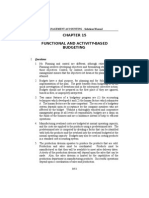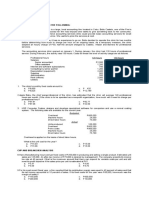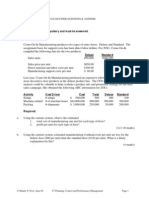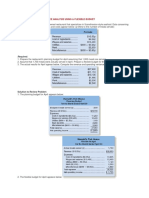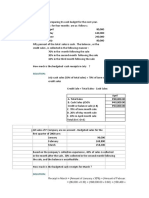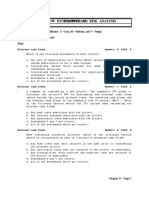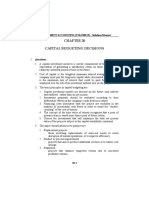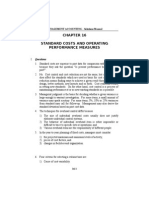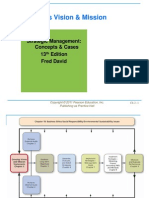Chapter 25 - Answer
Uploaded by
AgentSkySkyChapter 25 - Answer
Uploaded by
AgentSkySkyMANAGEMENT ACCOUNTING - Solutions Manual
CHAPTER 25
MANAGING PRODUCTIVITY AND
MARKETING EFFECTIVENESS
I.
Questions
1. Productivity is the relationship between the output and the input resources
required for generating the output.
2. A critical success factor for a firm that competes as a cost leader is to be
the low cost provider. A low cost provider needs to perform the required
tasks for the same output with fewer resources than its competitors.
3. Among criteria that often are used in assessing productivity and their
advantages and disadvantages are:
Using a prior years productivity as the criterion
Advantages:
Data readily available
Facilitates monitoring of continuous improvements
Disadvantages:
Difficult to assess adequacy of productivity improvements
Hard to compare productivity improvements between the years
Using the best performance as the criterion
Advantages:
Provides as the benchmark the utmost performance
Motivates people to strive for the maximum potential
Disadvantages:
The standard can be too high for the operation and frustrating to
workers
Data may be difficult to obtain
The criteria on which the operation is based may not be comparable
4. An operational productivity is the ratio of the output to the number of
units of an input resource.
25-1
Chapter 25 Managing Productivity and Marketing Effectiveness
A financial productivity measures the relationship between the output and
the cost of one or more of the input resources.
5. A partial productivity is a productivity measure that focuses only on the
relationship between the amount of one of the input resources and the
output attained.
A total productivity measures the relationship between the output and the
total input costs of all the required input resources for the output.
6. Manufacturing personnel often prefer operational productivity measures
over financial productivity measures because all the input data for
computing operational productivity measures are either results of their
activities or resources consumed for these activities.
Financial
productivity measures use costs of resources that often are results of
activities by personnel outside of manufacturing functions.
7. Measurements of marketing effectiveness include market share, sales
price, sales mix, and sales quantity variances.
8. Sales quantity variance is a component of sales volume variance. A sales
volume variance can be the result of both sales mix and sales quantity
variances.
9. A market size variance measures the effect on the contribution margin and
operating income of a firm because of changes in the total market size for
all firms in the same industry or product segment. A market share
variance examines the effect on the contribution margin and operating
income of a firm because of deviations of the firms actual market shares
from its budgeted market shares.
10. a. No. A multi-product firm can still have an unfavorable sales volume
variance even if it sells more than the budgeted units of sales. The
unfavorable sales volume variance is a result of selling more of less
profitable products and less of more profitable products.
b. A favorable sales quantity variance reflects the marketing managers
excellent performances only if there is no adverse change in selling
prices, sales mix, or market size. A favorable sales quantity variance
is hardly favorable to the firm if the firm has lowered its selling prices
or sold more of low-priced, low-margin and less of high-priced, highmargin products. Increases in the total market size in which the firm
operates often also leads to a favorable sales quantity variance. A
favorable sales quantity variance in an expanding total market may
not be favorable to the firm strategically if the firm also has an
unfavorable market share variance.
25-2
Managing Productivity and Marketing Effectiveness Chapter 25
A firm can have a favorable market size variance and an unfavorable
market share variance if the proportional increase of the firms total
sales is less than those of the total market.
c. Yes. The Wall Street Journal reported on April 14, 1994 (p. B4) that
Colgate-Palmolive had slashed marketing spending to reach its
ambitious target of 15 percent annual earnings growth. The firm, for
example, spent P88.8 million on advertising in 1993, compared with
P97.5 million in 1992. The firm met the goal of a 15 percent increase
in per share earnings and its CEO, Mr. Mark, expected the company
to announce a similar increase for first quarter earnings soon. The
market share of the firm, however, have decreased in all categories.
11. The sales volume variance is the sum of sales quantity and sales mix
variances. The sales quantity variance is the sum of market size and
market share variances.
II. Problems
Problem 1 (Operational and Financial Partial Productivity)
Requirement 1
Star Company
Comparative Income Statement
For the years 2005 and 2006
Sales
Variable cost of sales:
Materials
Labor
Power
Total variable costs of sales
Contribution margin
15,000 x P40 =
12,000 x P 8 =
6,000 x P20 =
1,000 x P 2 =
2005
P600,000
P 96,000
120,000
2,000
P218,000
P382,000
18,000 x P40 =
12,600 x P10 =
5,000 x P25 =
2,000 x P 2 =
2006
P720,000
P126,000
125,000
4,000
P255,000
P465,000
Change in profits from 2005: P465,000 P382,000 = P83,000 increase
Requirement 2
Operational Partial Productivity
DM
DL
Power
2006
18,000 / 12,600 = 1.4286
18,000 / 5,000 = 3.6
18,000 / 2,000 = 9
25-3
2005
15,000 / 12,000 =
15,000 / 6,000 =
15,000 / 1,000 =
1.25
2.5
15
Chapter 25 Managing Productivity and Marketing Effectiveness
Requirement 3
Total cost of production factors
DM
DL
Power
2006
2005
12,600 x P10 = P126,000 12,000 x P 8 = P 96,000
5,000 x P25 = P125,000 6,000 x P20 = P120,000
2,000 x P 2 = P 4,000 1,000 x P 2 = P 2,000
Financial Partial Productivity
DM
DL
Power
2006
18,000 / 126,000 = 0.1429
18,000 / 125,000 = 0.144
18,000 / 4,000 = 4.5
2005
15,000 / 96,000 = 0.15625
15,000 / 120,000 = 0.125
15,000 / 2,000 = 7.5
Requirement 4
Both direct materials and direct labor operation partial productivity improved
from 2005 to 2006. In 2006 the firm was able to manufacture more output
units for each unit of materials placed into production and for each hour spent
on production. The operational productivity of power in 2006 deteriorated
from 2005. It is likely that the firm used more equipment in production in
2006 that reduced consumption of materials and production hours.
The financial partial productivity for both direct materials and power
deteriorated from 2005 to 2006. Increases in direct materials costs were more
than the improvements in operational partial productivity for direct materials.
Like the operational partial productivity, the financial partial productivity for
direct labor also improved. The extent of improvements, however, is much
lower in financial partial productivity. The direct labor operational partial
productivity improved 44 percent in 2006 over those of 2005. The financial
partial productivity, however, improved only 15.2 percent between the two
years. The decrease in financial partial productivity is likely a result of
increases in direct labor wages.
Requirement 5
Operating Data for Decomposing Financial Productivity Measure
2006 Output,
2006 Output
2006 Output
25-4
2005 Output
Managing Productivity and Marketing Effectiveness Chapter 25
1/2006
Productivity
2006 Input cost
1/2005
Productivity
2006 Input cost
1/2005
Productivity
2005 Input cost
1/2005
Productivity
2005 Input cost
18,000
18,000
15,000
12,000/15,000
= 0.8
6,000/15,000
= 0.4
1,000/15,000
= 0.0667
12,000/15,000
= 0.8
6,000/15,000
= 0.4
1,000/15,000
= 0.0667
12,000/15,000
= 0.8
6,000/15,000
= 0.4
1,000/15,000
= 0.0667
P 8
P20
P 2
P 8
P20
P 2
18,000 x 0.8 x 10
= P144,000
18,000 x 0.4 x 25
= P180,000
18,000 x 0.0667 x 2
= P2,401
P326,401
18,000 x 0.8 x 8
= P115,200
18,000 x 0.4 x 20
= P144,000
18,000 x 0.0667 x 2
= P2,401
P261,601
15,000 x 0.8 x 8
= P96,000
15,000 x 0.4 x 20
= P120,000
15,000 x 0.0667 x 2
= P2,001
P218,001
18,000 / 144,000
= 0.125
18,000 / 115,200
= 0.15625
15,000 / 96,000
= 0.15625
18,000 / 180,000
= 0.1
18,000 / 2,401
= 7.4969
18,000 / 144,000
= 0.125
18,000 / 2,401
= 7.4969
15,000 / 120,000
= 0.125
15,000 / 2,001
= 7.4963
(1) Output (unit):
18,000
(2) 1/Productivity
DM: 12,600/18,000
= 0.7
DL: 5,000/18,000
= 0.2778
Power: 2,000/18,000
= 0.1111
(3) Cost per unit of input
DM:
P10
DL:
P25
Power: P 2
P10
P25
P 2
(4) Output x (1/Productivity) x Input cost
DM: 18,000 x 0.7 x 10
= P126,000
DL: 18,000 x 0.2778 x 25
= P125,010
Power: 18,000 x 0.1111 x 2
= P4,000
Total P255,010
Decomposition
DM: 18,000 /
126,000
= 0.1429
DL: 18,000 / 125,010
= 0.1440
Power: 18,000 /
4,000
= 4.5
Productivity change
DM:
0.1429 0.125
= 0.0179 F
Input price change
0.125 0.15625
= 0.03125 U
25-5
Output change
0.15625 0.15625
=0
Chapter 25 Managing Productivity and Marketing Effectiveness
DL:
0.144 0.1
= 0.044 F
Power: 4.5 7.4969
= 2.9969 U
0.1 0.125
= 0.025 U
7.4969 7.4969
=0
0.125 0.125
=0
7.4969 7.4963
= 0.0006 (rounding)
Summary of Result
DM:
DL:
Power:
Productivity
Change
0.0179 F
0.044 F
2.9969 U
Input Price
Change
0.03125 U
0.025 U
0
Total
Change
0.01335 U
0.019 F
2.9969 U
Change as % of 2005 Productivity
Productivity Input Price
Total
Change
Change
Change
11.46% F 20% U
8.54% U
35.2% F 20% U
15.2% F
39.98% U 0
39.98% U
Requirement 6
Productivity for both direct materials and direct labor improved in 2006. The
percentages of improvements in productivity are 11.46 and 35.2 for direct
materials and direct labor, respectively, of the 2005 productivity. However,
cost increases in direct materials and direct labor reduced the gains in
productivity on these two manufacturing factors.
Problem 2 (Direct Labor Rate and Efficiency Variances, Productivity
Measures, and Standard Costs)
Requirement 1
Assembly Department Direct Labor Variances
2005:
Total actual direct labor hours:
Total standard direct labor hours:
P30 x 500,000
= P15,000,000
25 x 20,000 = 500,000
24 x 20,000 = 480,000
P28 x 500,000
= P14,000,000
25-6
P28 x 480,000
= P13,440,000
Managing Productivity and Marketing Effectiveness Chapter 25
Rate variance
= P1,000,000 U
Efficiency variance
= P560,000 U
2006:
Total actual direct labor hours:
Total standard direct labor hours:
P36 x 400,000
= P14,400,000
20 x 20,000 = 400,000
21 x 20,000 = 420,000
P35 x 400,000
= P14,000,000
Rate variance
= P400,000 U
P35 x 420,000
= P14,700,000
Efficiency variance
= P700,000 F
Testing Department Direct Labor Variances
2005:
Total actual direct labor hours:
Total standard direct labor hours:
P20 x 240,000
= P4,800,000
12 x 20,000 = 240,000
14 x 20,000 = 280,000
P21 x 240,000
= P5,040,000
Rate variance
= P240,000 F
Efficiency variance
= P840,000 F
2006:
Total actual direct labor hours:
Total standard direct labor hours:
P24 x 200,000
= P4,800,000
P21 x 280,000
= P5,880,000
10 x 20,000 = 200,000
11 x 20,000 = 220,000
P25 x 200,000
= P5,000,000
Rate variance
= P200,000 F
P25 x 220,000
= P5,500,000
Efficiency variance
= P500,000 F
Recap:
Rate variance
Efficiency variance
Assembly Department
2005
2006
P1,000,000 U P400,000 U
P560,000 U
P700,000 F
25-7
Testing Department
2005
2006
P240,000 F
P200,000 F
P840,000 F
P500,000 F
Chapter 25 Managing Productivity and Marketing Effectiveness
Requirement 2
Assembly Department Operational Partial Productivity
2005:
2006:
20,000 / 500,000 = 0.04
20,000 / 400,000 = 0.05
Testing Department Operational Partial Productivity
2005:
2006:
20,000 / 240,000 = 0.0833
20,000 / 200,000 = 0.1
Requirement 3
Assembly Department Financial Partial Productivity
2005:
2006:
20,000 / P15,000,000 = 0.001333
20,000 / P14,400,000 = 0.001389
Testing Department Financial Partial Productivity
2005:
20,000 / P4,800,000 = 0.004167
2006:
20,000 / P4,800,000 = 0.004167
Requirement 4
Operational partial productivity
Assembly
Testing
2005
0.04
0.0833
2006
0.05
0.1
0.01
0.0167
Change
F
25%
F
20%
F
F
Financial partial productivity
Assembly
Testing
2005
0.001333
0.004167
2006
0.001389
0.004167
Change
0.000056 F
4.2%
-0-0-
Operational partial productivity improved in both departments from 2005 to
2006. The financial partial productivity in the Assembly also improved while
the Testing remains unchanged.
Requirement 5
25-8
Managing Productivity and Marketing Effectiveness Chapter 25
The standards in a standard costing system often are determined independently
and incorporate changes in operating factors. The standard for the operation
of a year may change because of changes in, for example, technology, quality
of materials, experience of production workers, designs, or processes.
Productivity measures use as the criterion the productivity of a prior year
without adjusting for changes occurred or the expected changes for the current
year. As a result, assessments of productivity may depict an entirely different
picture than those of variance analyses in a standard costing system.
Problem 3 (Sales Variance)
Requirement 1
Selling price variances (in 000)
Flexible budget sales:
Premium
Regular
Barrels
Sales
Master Budget for 2005
Budgeted
Total Units
Total
Selling Price
Sold in
Sales
Units
Per Unit
2005
P150
x
180 =
P36,000
240 =
P120
x
540 =
P43,200
360 =
Premium
Regular
Selling
Flexible
Price
Flexible
Actual
Budget
Variance
Actual
Budget
180
180
540
540
P28,800
P27,000
P1,800 F
P62,100
P64,800
Flexible
Budget
Sales
P27,000
P64,800
Selling
Price
Variance
P2,700 U
Total selling price variance of the firm = P1,800 F + P2,700 U = P900 U
Requirement 2
Sales volume variances for the period for each of the products and for the firm
25-9
Chapter 25 Managing Productivity and Marketing Effectiveness
Flexible budget variable expenses:
Master Budget for 2005
Total
Variable
Number of
Expenses
Units
P21,600
240 =
P27,000
360 =
Premium
Regular
Budgeted
Variable
Expenses
Per Unit
P90
x
P75
x
Total
Units
Sold in
2005
180 =
540 =
Premium
Barrels
Sales
Variable
expenses
Contribution
margin
Fixed
expenses
Operating
income
Regular
Flexible
Budget
180
P27,000
Master
Budget
180
P36,000
16,200
21,600
P10,800
P14,400
10,000
P
800
Flexible
Budget
Variable
Expenses
P16,200
P40,500
Sales
Volume
Variance
Sales
Volume
Variance
Flexible
Budget
540
P64,800
Master
Budget
360
P43,200
40,500
27,000
P3,600 U
P24,300
P16,200
P8,100 F
10,000
5,000
5,000
P 4,400
P3,600 U
P19,300
P11,200
P8,100 F
Total sales volume variance of the firm = P3,600 U + P8,100 F = P4,500 F
Requirement 3
Sales quantity variances for the firm and for each of the products. (See next
page.)
Requirement 4
Sales mix variances for the period for each of the products and for the firm
(000 omitted).
Calculation for sales mixes:
Premium
Regular
Budgeted
Total Sales
Sales
in Units
Mix
240
0.40
360
0.60
600
1.00
Flexible Budget
Total actual units of all
products sold x Actual
Total actual units of
all products sold x
25-10
Actual
Total Sales
in Units
180
540
720
Sales
Mix
0.25
0.75
1.00
Master Budget
Total budgeted units of
sales for all products x
Managing Productivity and Marketing Effectiveness Chapter 25
sales mix x Standard
contribution margin per
unit
Budgeted sales mix x
Standard contribution
margin per unit
Budgeted sales mix x
Standard contribution
margin per unit
720 x 0.25 x P60 = P10,800
720 x 0.40 x P60 = P17,280
Premium
Sales mix variance
= P6,480 U
600 x 0.40 x P60 = P14,400
Sales quantity variance
= P2,880 F
Sales volume variance
= P10,800 P14,400
= P3,600 U
To verify: Sales volume variance
= Sales mix variance + Sales quantity variance
=
P6,480 U
+
P2,880 F
=
P3,600 U
Regular
720 x 0.75 x P45 = P24,300
720 x 0.60 x P45 = P19,440
Sales mix variance
= P4,860 F
600 x 0.60 x P45 = P16,200
Sales quantity variance
= P3,240 F
Sales volume variance
= P24,300 P16,200
= P8,100 F
To verify: Sales volume variance
= Sales mix variance + Sales quantity variance
=
P4,860 F
+
P3,240 F
=
P8,100 F
Total
Sales mix variance
= P6,480 U + P4,860 F = P1,620 U
Sales quantity variance = P2,880 U + P3,240 F = P6,120 F
25-11
Chapter 25 Managing Productivity and Marketing Effectiveness
Requirement 5
Verification
Premium
Regular
Total
Sales mix variance +
P6,480 U
P4,860 F
P1,620 U
Sales quantity variance =
P2,880 F
P3,240 F
P6,120 F
Sales volume variance
P3,600 U
P8,100 F
P4,500 F
Requirement 6
Market size variances. (See below.)
Requirement 7
Market share variances (000 omitted. See below.)
Weighted average budgeted contribution margin per unit
Master budget total contribution margin
P30,600
Master budget total sales units
600
Weighted-average budgeted contribution margin per unit P
51
Calculation for market shares:
Budgeted: Total sales in units 600 Total sales of the industry 1,500 = 0.40
Actual:
Total sales in units 720 Total sales of the industry 1,600 = 0.45
Calculation for variances:
Actual total market
size x Actual market
share x Average
budgeted contribution
margin per unit
1,600 x 0.45 x P51
= P36,720
Actual total market x
Budgeted market
share x Average
budgeted contribution
margin per unit
1,600 x 0.40 x P51
= P32,640
Market share variance
= P4,080 F
Market size variance
= P2,040 F
Sales quantity variance
= P4,080 F + P2,040 F
= P6,120 F
Requirement 8
25-12
Budgeted total market
size x Budgeted market
share x Average
budgeted contribution
margin per unit
1,500 x 0.40 x P51
= P30,600
Managing Productivity and Marketing Effectiveness Chapter 25
The sum of market size variance and market share variance and verification
that this total equals the sales quantity variance.
Total market size variance + Total market share variance =
P2,040 F
P4,080 F
Total quantity variance
P6,120 F
Problem 4 (Productivity and Ethics)
Requirement 1
The operational partial productivity deteriorates slightly from 0.0051 in 2005
(500/99,000) to 0.005 in 2006 (560/112,000). Manipulating accounting
numbers in order to show a desirable result is an unethical behavior regardless
the intention.
Requirement 2
Tan should not follow the order without following a consistent accounting
method. If the firm believes that certain cost items should be reclassified as
indirect costs, the same procedure should be followed for all years. Tan
should then go back and revise operating results of previous years.
Problem 5 (Small Business Market Size and Share Variances)
Requirement 1
WS
DH
Empress
Designs
50
25
Budget
Industry
500
200
Share
10.0%
12.5%
Empress
Designs
45
35
Actual
Industry
425
150
Share
45/425
35/150
Requirement 2
Weighted Average Budgeted Contribution Margin Per Unit:
(50 welcome signs x P2) + (25 doghouses x P5.20) / 75 = P3.07
Market Share Variance
25-13
Chapter 25 Managing Productivity and Marketing Effectiveness
Welcome Signs: (45/425 0.1) x 425 x P3.07 = P7.68 F
Doghouses: (35/150 25/200) x 150 x P3.07 = P49.89 F
Requirement 3
Market Size Variance
Welcome Signs: (45 500) x 50/500 x P3.07 = P23.03 U
Doghouses: (150 200) x 25/200 x P3.07 = P19.19 U
Requirement 4
Among possible reasons are quality changes, pricing changes, less producers
due to seasonal variations, and market no longer there.
Requirement 5
Among alternatives are improving costs through adopting activity based
costing, making different signs, using less expensive wood, finding competitive
advantage.
III. Multiple Choice Questions
1.
2.
3.
4.
5.
6.
7.
8.
9.
10.
A
C
B
D
A
C
C
B
C
D
11.
12.
13.
14.
15.
16.
17.
18.
19.
20.
A
B
A
B
C
D
B
C
A
D
21.
22.
23.
24.
A
D
C
D
Supporting Computations:
Operational partial productivity
Output
2005
Input
Partial
25-14
Output
2006
Input
Partial
Managing Productivity and Marketing Effectiveness Chapter 25
X-45
Direct
labor
60,000
Resource
Used
Productivity
75,000 =
0.8
64,000
(1)
60,000
10,000 =
64,000
6.0
Direct
labor
10,847 =
5.9002
(2)
Financial partial productivity
X-45
Resource
Used
Productivity
89,600 =
0.7143
2005
Cost of Input
Units of
Resource
Partial
Output
Used
Productivity
0.1111
60,000 P540,000 =
2006
Cost of Input
Units of
Resource
Partial
Output
Used
Productivity
0.1050
64,000 P609,280 =
(3)
60,000
300,000 =
0.2
Total productivity in units
(a) Total units manufactured
(b) Total variable manufacturing costs
incurred
(c) Total productivity (a) (b)
(d) Decrease in productivity
64,000 P347,104 =
(4)
2005
60,000
0.1844
2006
64,000
P840,000
P956,384
0.071429 (5) 0.066919
0.071429 0.066919 = 0.00451 (6)
Total productivity in sales pesos
(a) Total sales
(b) Total variable manufacturing costs
incurred
(c) Total productivity (a) (b)
(d) Decrease in productivity
2005
P1,500,000
2006
P1,600,000
P840,000
P1.7857 (5)
P1.7857 P1.6730 =
P956,384
P1.6730
P0.1127 (6)
(7) Operational partial productivity:
Operational Partial Productivity =
Actual Production
Actual Input
9,500
8,950
(8) Financial partial productivity:
(1) Output
(2) Direct materials:
Quantity
Unit cost
Total direct materials cost
25-15
2005
400,000
2006
486,000
160
x P3,375
P540,000
180
x P3,125
P562,500
= 1.06
Chapter 25 Managing Productivity and Marketing Effectiveness
(3) DM financial partial
productivity (1) (2)
(4) Direct labor:
Hour spent
Hourly wage
Total direct labor cost
(5) DL financial partial
productivity (1) (4)
0.7407
0.864
10,000
x
P26
P260,000
13,500
x
P25
P337,500
1.5385
1.44
2005
400,000
2006
486,000
P540,000
260,000
P800,000
0.5
P562,500
337,500
P900,000
0.54
(9) Total productivity:
(1) Output
Total cost:
Direct materials cost
Direct labor cost
(2) Total cost
(3) Total productivity (1) (2)
Market Share
Actual
Budget
1.
2.
3.
Firm
100,000
90,000
Total Market
2,000,000 =
1,500,000 =
/
/
Market Share
5%
6%
Market size variance: (2,000,000 1,500,000) x 0.06 x P8 = P240,000 F (10)
Market share variance: (5% - 6%) x 2,000,000 x P8
= P160,000 U (11)
Sales quantity variance: (100,000 90,000) x P8
= P 80,000 F (12)
(13)
Budgeted sales unit
Budgeted contribution margin per
unit
Budgeted total contribution margin
Budgeted average contribution margin
per unit
Product A
30,000
Product B
60,000
Total
90,000
x P4.00
P120,000
x P10.00
P600,000
P720,000
P8.00
(14)
Actual units sold
Product A
35,000
25-16
Product B
65,000
Total
Managing Productivity and Marketing Effectiveness Chapter 25
Budgets sales unit
Differences in sales units
Budgeted contribution margin per
unit
Sales volume contribution margin
variance
30,000
5,000
60,000
5,000
x P10.00
P4.00
P20,000 F
P50,000 F
P70,000 F
Sales mixes:
Product A
Product B
TOTAL
Budgeted
Unit
%
30,000
1/3
60,000
2/3
90,000
100
Actual
Unit
35,000
65,000
100,000
%
35
65
100
(15)Sales mix contribution margin variance:
Product A: (0.35 1/3) x 100,000 x P4 =
Product B: (0.65 2/3) x 100,000 x P10 =
Total sales mix contribution margin variance
P 6,667 F
16,667 U
P10,000 U
(16)Sales quantity contribution margin variance:
Product A: (100,000 90,000) x 1/3 x P4 =
Product B: (100,000 90,000) x 2/3 x P10 =
Total sales quantity contribution margin variance
P13,333 F
66,667 F
P80,000 F
(17)Weighted average budget contribution margin per unit:
P8.00 (calculated in no. 13)
Market size contribution margin variance:
(2,000,000 1,500,000) x 90,000 / 1,500,000 x P8 = P240,000 F
(18)Market share contribution margin variance:
(100,000 / 2,000,000 90,000 / 1,500,000) x 2,000,000 x P8 =
P160,000 U
(19)Flexible budget contribution margin variance:
Total Contribution margin
25-17
Flexible
Budget
Contribution
Chapter 25 Managing Productivity and Marketing Effectiveness
Product A
Product B
TOTAL
Actual Operating Result
35,000 x P3 = P105,000
65,000 x P12 = P780,000
P885,000
Flexible Budget
35,000 x P4 = P140,000
65,000 x P10 = P650,000
P790,000
Margin Variance
P 35,000 U
P130,000 F
P 95,000 F
(20)Total contribution margin price variance (given)
P50,000 F
Sales price variance:
Product A: (P12 P10) x 35,000 =
P70,000 F
Product B: (P24 P25) x 65,000 =
P65,000 U
Total sales price variance
5,000 F
Total variable cost price variance
P45,000 F
(21)Total flexible budget contribution margin variance
Total contribution margin price variance (given)
Total variance cost efficiency variance
P95,000 F
50,000 F
P45,000 F
(22)Sales mix ratio:
R66
R100
TOTAL
Actual
Quantity
1,000
1,000
2,000
Ratio
0.50
0.50
1.00
Budget
Quantity
1,200
400
1,600
Ratio
0.75
0.25
1.00
R66 sales quantity variance: (2,000 1,600) x 0.75 x P10 = P3,000 F
(23)R100 sales mix variance: (0.5 0.25) x 2,000 x P70 = P35,000 F
(24)Total sales volume variance:
R66:
R100:
Total
(1,000 1,200) x P10 =
(1,000 400) x P70 =
25-18
P 2,000 U
42,000 F
P40,000 F
You might also like
- Reviewer in Intacc 3 Intermediate Accounting 3 - CompressNo ratings yetReviewer in Intacc 3 Intermediate Accounting 3 - Compress13 pages
- Qualifying Examination: Financial Accounting 2No ratings yetQualifying Examination: Financial Accounting 211 pages
- EXERCISE On Performance Measurement in Decentralized OrganizationsNo ratings yetEXERCISE On Performance Measurement in Decentralized Organizations3 pages
- Cost Concepts and Analysis: Management Advisory ServicesNo ratings yetCost Concepts and Analysis: Management Advisory Services7 pages
- Subject: ED 801 Statistics II: Ratio Level of MeasurementNo ratings yetSubject: ED 801 Statistics II: Ratio Level of Measurement4 pages
- Part I. Multiple Choice Questions: Select The Best Statement or Words That Corresponds To The QuestionNo ratings yetPart I. Multiple Choice Questions: Select The Best Statement or Words That Corresponds To The Question8 pages
- Tiong, Gilbert Charles - Decision MakingNo ratings yetTiong, Gilbert Charles - Decision Making11 pages
- Mas 12 - Operating and Financial BudgetingNo ratings yetMas 12 - Operating and Financial Budgeting4 pages
- Drill 2 Working Capital Current Liabilities ANSWERS PDFNo ratings yetDrill 2 Working Capital Current Liabilities ANSWERS PDF7 pages
- Explain The Difference in Attitude To Risk Between European and US CompaniesNo ratings yetExplain The Difference in Attitude To Risk Between European and US Companies3 pages
- Arias, Kyla Kim B. - Midterm Project Sept 30No ratings yetArias, Kyla Kim B. - Midterm Project Sept 309 pages
- The Expenditure Cycle: Purchasing To Cash Disbursements Instructors Manual Learning ObjectivesNo ratings yetThe Expenditure Cycle: Purchasing To Cash Disbursements Instructors Manual Learning Objectives17 pages
- 6840 - PAS 37 Provisions Contingent Liabilities and Contingent AssetsNo ratings yet6840 - PAS 37 Provisions Contingent Liabilities and Contingent Assets6 pages
- Activitybased Costing May 20 GMSISUCCESSNo ratings yetActivitybased Costing May 20 GMSISUCCESS29 pages
- Job Order, Operation and Life Cycle Costing Job Order CostingNo ratings yetJob Order, Operation and Life Cycle Costing Job Order Costing19 pages
- Requirement 1: Solutions To Seatwork #1 Strategic Cost Management Sisc Problem 1 (Close or Retain A Store)No ratings yetRequirement 1: Solutions To Seatwork #1 Strategic Cost Management Sisc Problem 1 (Close or Retain A Store)6 pages
- Chapter 16 Managing Productivity and Marketing EffectivenessNo ratings yetChapter 16 Managing Productivity and Marketing Effectiveness16 pages
- David SM Chapter 2 PPT by Fred R David Stategic Management Concepts and Cases 13th Edition0% (2)David SM Chapter 2 PPT by Fred R David Stategic Management Concepts and Cases 13th Edition38 pages
- Reviewer in Intacc 3 Intermediate Accounting 3 - CompressReviewer in Intacc 3 Intermediate Accounting 3 - Compress
- Summary of George Stalk's Competing Against TimeFrom EverandSummary of George Stalk's Competing Against Time
- EXERCISE On Performance Measurement in Decentralized OrganizationsEXERCISE On Performance Measurement in Decentralized Organizations
- Cost Concepts and Analysis: Management Advisory ServicesCost Concepts and Analysis: Management Advisory Services
- Subject: ED 801 Statistics II: Ratio Level of MeasurementSubject: ED 801 Statistics II: Ratio Level of Measurement
- Part I. Multiple Choice Questions: Select The Best Statement or Words That Corresponds To The QuestionPart I. Multiple Choice Questions: Select The Best Statement or Words That Corresponds To The Question
- Drill 2 Working Capital Current Liabilities ANSWERS PDFDrill 2 Working Capital Current Liabilities ANSWERS PDF
- Explain The Difference in Attitude To Risk Between European and US CompaniesExplain The Difference in Attitude To Risk Between European and US Companies
- The Expenditure Cycle: Purchasing To Cash Disbursements Instructors Manual Learning ObjectivesThe Expenditure Cycle: Purchasing To Cash Disbursements Instructors Manual Learning Objectives
- 6840 - PAS 37 Provisions Contingent Liabilities and Contingent Assets6840 - PAS 37 Provisions Contingent Liabilities and Contingent Assets
- Job Order, Operation and Life Cycle Costing Job Order CostingJob Order, Operation and Life Cycle Costing Job Order Costing
- Requirement 1: Solutions To Seatwork #1 Strategic Cost Management Sisc Problem 1 (Close or Retain A Store)Requirement 1: Solutions To Seatwork #1 Strategic Cost Management Sisc Problem 1 (Close or Retain A Store)
- Chapter 16 Managing Productivity and Marketing EffectivenessChapter 16 Managing Productivity and Marketing Effectiveness
- David SM Chapter 2 PPT by Fred R David Stategic Management Concepts and Cases 13th EditionDavid SM Chapter 2 PPT by Fred R David Stategic Management Concepts and Cases 13th Edition


